2. 中国农业科学院农业资源与农业区划研究所, 耕地培育技术国家工程实验室, 北京 100081;
3. 中国农业科学院农业资源与农业区划研究所, 祁阳农田生态系统国家野外科学观测研究站, 湖南祁阳 426182;
4. 江西省红壤研究所, 国家改良工程技术研究中心, 江西进贤 331717
2. Institute of Agricultural Resources and Reginal Planning, Chinese Academy of Agricultural Sciences, National Engineering Laboratory for Improving Quality of Arable Land, Beijing 100081, China;
3. National Observation Station of Qiyang Agri-ecology System, Institute of Agricultural Resources and Regional Planning, CAAS, Qiyang, Hunan 426182, China;
4. National Engineering and Technology Research Center for Red Soil Improvement, Jiangxi Institute of Red Soil, Jinxian, Jiangxi 331717, China
红壤总面积5690万公顷,是我国南方最重要的土壤类型之一[1]。大多数红壤有机质含量低,铝含量高,保肥保水性能差[2],严重缺钾[3–4]。大量施用化肥[3, 5–9]和频繁酸雨[10–11]加快了红壤酸化速度[12],扩大了酸化面积,进一步加剧了土壤钾素有效性低的问题[13]。施用石灰是阻控土壤酸化[14],提高红壤生产力的有效措施[15]。施用石灰不仅可以中和酸化红壤的活性酸和潜性酸,而且可增加有效阳离子交换量[2],提高钾的有效性[10]。因此研究红壤酸化及其改良、校正过程中钾素的有效性对提高红壤生产力有重要理论意义和实践价值。钾的有效性指的是能被植物吸收利用的程度[16]。钾养分通过植物根系吸收进入植物体,而根系通过吸收和物质分泌作用改变了根际土壤的化学组成、物理结构和生物学性质,进而影响土壤中钾养分有效性。根际是围绕于植物根系周围很小的土壤微域。受根系生理活动的影响,在物理、化学和生物特性上不同于非根际土壤(本体土壤)的特殊区域[17]。由于根际微域内的有效养分为实际有效养分,能直接为根系吸收,决定着作物实际吸收的养分量,而非根际土壤中的有效养分只是潜在有效养分,还需要通过迁移等供应过程才能为根吸收[18]。根际有效钾养分状况的变化可直接反映其生物有效性和植物对钾养分利用能力的大小[19]。李小坤[20]在红壤性水稻土上的研究表明,在水旱轮作条件下,作物首先吸收利用根区土壤水溶性钾,随着作物生长和吸钾强度的增大,根区土壤交换性钾和非交换性钾向水溶性钾转化。在养分缺乏土壤上,作物可分泌质子及有机酸等促进根区土壤养分有效化[21];但丛日环等[22]在红壤上的研究表明,无论加入外源钾与否,有机酸的存在均加快了根际交换性钾向水溶性钾的转化,可能原因是有机酸主要通过增加可变电荷土壤表面的净负电荷来增加土壤对K+的吸附量。持续作物种植导致红壤钾素耗竭,严重降低土壤供钾水平和作物生长,钾肥施用可以提高根际与非根际土壤交换性钾和缓效钾含量,也有效提高了作物产量[23]。李小梅[24]研究显示,根际土壤钾养分含量随钾肥用量的增加先增大后逐渐减少,表明其并不和施钾量成正比提高。但也有研究显示,红壤在各种施钾水平下,根际交换性钾和缓效钾均出现亏缺[25]。王益福[26]研究表明,果园铺草覆盖能显著提高红壤根际钾养分有效性,可能原因是铺草区其根际土壤微生物的种群比深耕、浅耕区丰富,且数量众多。酸化在一定程度上可增加红壤钾元素的溶解度,但由于钾离子代换能力小于氢、铝离子,容易被从土壤胶体中置换出来,从而加速了其向土壤溶液中的转化,也更易于从土壤中淋溶[18, 27],使得土壤中钾营养元素的有效性更低[28]。大量研究表明,施用石灰可通过降低红壤酸度,进而提高酸化红壤钾养分有效性[24, 29–33]。但是不同酸化程度土壤及其经施石灰改良后,初始酸度对土壤及根际钾素有效性的影响尚不清楚,而有关于种植冬小麦条件下在哪一具体pH范围内施石灰改良酸化红壤对提高钾的有效性起作用则没有涉及。采用盆栽根际袋法,研究不同程度酸化红壤及其经施用石灰矫正酸度后,对冬小麦根际和非根际土壤钾素有效性的影响,了解初始酸度对石灰改良红壤钾素有效性的效应,寻求石灰改良酸化红壤最佳时机,为酸化红壤有效改良提供依据和支撑。
1 材料与方法 1.1 供试土壤供试土壤母质为第四纪红土,采自中国农业科学院祁阳红壤试验站附近的自然植被恢复人工落叶松林地(E 111°52′,N 26°45′,海拔120 m),多点采集0—20 cm土样,带回实验室风干并混合均匀,挑出杂质,过20目筛。土壤pH值为4.3,通过酸碱滴定法[34],测定土壤的酸碱缓冲容量,然后取适量土样分为四部分,通过添加石灰和硫酸调节为4个pH梯度土壤(4.0、4.5、4.8、5.2),分别置于4个大塑料桶中,室温下保持土壤水分在70%田间持水量,培养一年使其pH达到稳定。培养结束后取出土样并风干,磨细过筛(20目),测定缓冲容量和土壤理化性质(表 1),备用。
| 表1 供试土壤基本化学性质 Table 1 Some chemical properties of acidified soils |
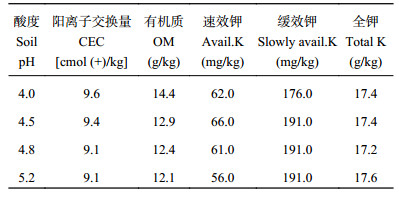 |
盆栽试验:盆栽试验分两组8个处理,第一组直接用表 1中4个pH梯度的土样(4个处理,代号为Acidified);用石灰将表 1中4个pH梯度的土样的pH调节到6.0做为第二组处理(代号为Limed),其目的在于消除土壤中铝毒[35]和冬小麦作物酸害[36]。在pH为4.0、4.5、4.8和5.2时石灰用量分别为3.4、1.9、1.0和0.7 g/kg土。校正pH后土样放置平衡10天[2]。
盆栽试验在温室中进行,温室位于湖南祁阳红壤试验站内。试验用盆直径12 cm,高15 cm。每盆装土1.65 kg。装盆前每盆施尿素0.35 g、过磷酸钙1.78 g、氯化钾0.27 g,混匀,取出其中150 g土装入直径3 cm、高12 cm的尼龙纱网根袋中(300目),置于盆中央,然后将其余1.5 kg土装入盆中。每个处理重复3次。全部盆装好后放置2天,然后在每盆的根袋中播入已催芽的冬小麦种子10粒,确保最后有6株冬小麦苗。加蒸馏水使每盆土壤水分达到田间持水量的70%,并每隔374天称重加水保持水分稳定。盆栽小麦生长时间为2014年11月13日至2015年2月2日收获,共历时80天。冬小麦生长期间大部分天数为多云天气,温度在1 ℃~23 ℃之间。
冬小麦生长结束后(植物地下部生长充满根袋),用剪刀紧挨土面将植株剪下,并仔细地拣出根袋中的所有小麦根系,分别洗净、烘干后称重。根袋中土样去掉表面2 cm土,收集袋内其余土作为根际土(Rhizospheric Soil-RS),将根袋外的土混匀,四分法取样做为非根际土(Bulk Soil-BS)。将所有土样风干,磨细过20目筛备用。
1.3 分析方法土样缓效钾用1 mol/L HNO3煮沸法提取[37];交换性钾用1 mol/L NH4OAC浸提[37];植株全钾用H2SO4-H2O2消煮。所有提取液或消煮待测液中的钾含量均用火焰光度法测定[36]。土壤pH用电位法测定[37];土壤阳离子交换量(CEC)用乙酸铵法测定[37];土壤有机质测定用重铬酸钾外加热容量法[37];缓冲容量用酸碱滴定法进行测定[34]。
1.4 数据计算与统计分析冬小麦吸钾量(g/pot)=植株干重(g/pot) ×植株钾含量(%) +根系干重(g/pot) ×根钾含量(%)
根际钾素富集率(%)=(根际土钾含量−非根际土钾含量)/非根际土钾含量× 100
富集率(Enrichment ratio, ER)表示根际对土壤营养元素的富集程度,反映根际效应的强弱[38]。
根际速效钾亏缺率(%)=(非根际速效钾含量−根际速效钾含量)/非根际速效钾含量× 100
根际钾离子饱和度亏缺率(%)=(非根际钾离子饱和度−根际钾离子饱和度)/非根际钾离子饱和度× 100
采用Excel 2003作图,SPSS 20.0软件进行统计分析,LSD法多重比较。
2 结果 2.1 酸化及石灰改良土壤冬小麦生物量酸化处理红壤冬小麦生物量在pH 4.0~4.8之间随pH升高而显著升高,pH 4.8和pH 5.2土壤间无显著差异(图 1)。施石灰改良处理冬小麦生物量也随土壤初始pH升高显著升高,且均显著高于相应的酸化土壤,在pH 4.0、4.5、4.8和5.2时分别提高180.7%、37.4%、26.0%、29.4% (图 1)。
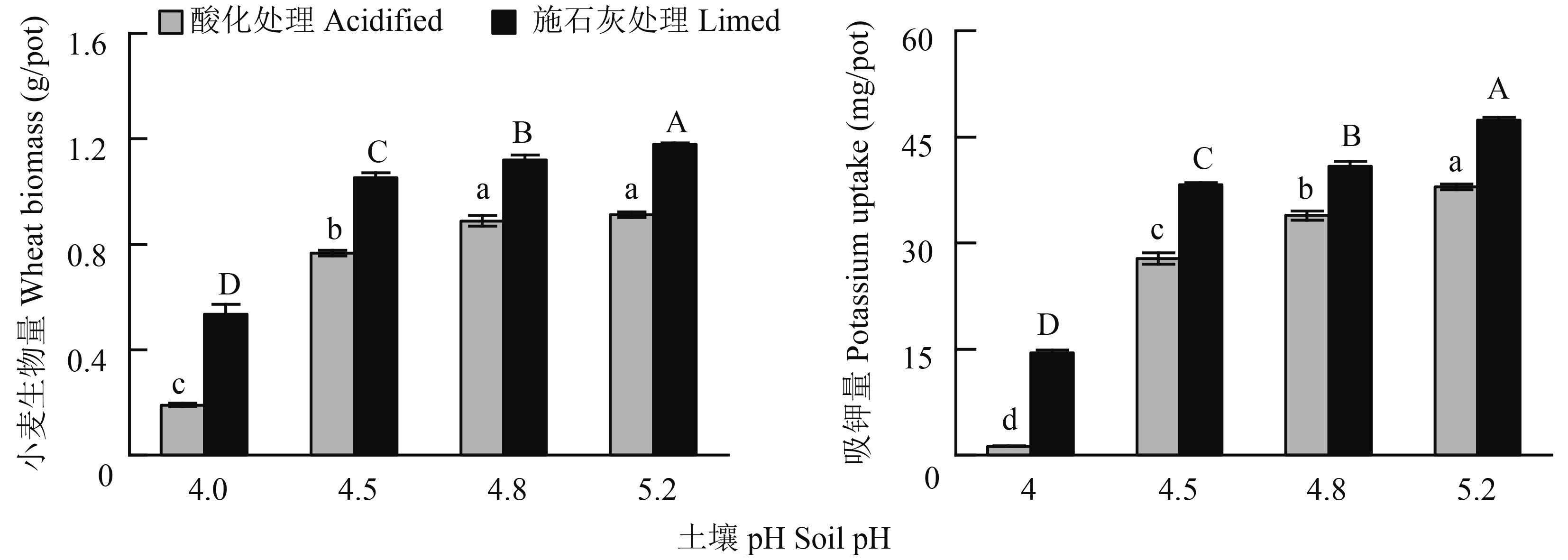 |
| 图1 酸化红壤及其经石灰改良至pH 6.0后红壤冬小麦生物量和钾吸收量 Fig. 1 Winter wheat biomass and K uptake in red soils before and after remediation with lime to pH 6 [注(Note):柱上不同小写字母表示酸化处理红壤各pH水平间差异显著Different lower case letters above the bars indicate the significant differences between pH level treatments in acidified soils at P < 5% level; 柱上不同大写字母表示石灰改良后红壤冬小麦生物量在不同初始pH水平处理间差异显著Different capital letters above the bars indicate significant difference among limed soils with differed with different initial pH values at P < 5% level] |
酸化土壤冬小麦吸钾量变幅为1.2~38.0 mg/pot,施石灰土壤冬小麦吸钾量变幅为14.4~47.3 mg/pot,均随pH或初始pH升高而显著增加(图 1)。且后者的吸钾量在pH 4.0、4.5、4.8和5.2时均显著高于前者,增幅分别达1076.9%、37.7%、20.5%、24.9%。
2.3 酸化及石灰改良土壤速效钾变化不同酸化处理冬小麦根际土壤速效钾含量在65.3~135.3 mg/kg之间,在pH4.0~4.8范围内随pH升高显著降低,pH4.8和pH5.2则无显著差异。非根际土壤速效钾含量范围为107.0~127.0 mg/kg,表现为pH 4.0 > pH 4.8=pH 5.2 > pH 4.5 (图 2)。在pH4.0下,根际土壤速效钾显著高于非根际土,根际富集率达6.1%;在pH 4.5、pH 4.8、pH 5.2处理中,根际土壤速效钾表现为亏缺,亏缺率分别为28.3%、44.0%、43.0%。
 |
| 图2 酸化红壤及其经石灰改良至pH6.0后冬小麦收获时根际和非根际土壤速效钾含量 Fig. 2 Available K content in rhizospheric and bulk soil in acidified red soils before and after lime remediation to pH 6 at winter wheat harvest [注(Note):柱上不同小写字母表示酸化处理红壤各pH水平间差异显著Different lower case letters above the bars indicate the significant differences between pH level treatments in acidified soils at P < 5% level; 柱上不同大写字母表示石灰改良后红壤冬小麦生物量在不同初始pH水平处理间差异显著Different capital letters above the bars indicate significant difference among limed soils with differed with different initial pH values at P < 5% level] |
施石灰改良处理根际土壤速效钾含量在39.7~45.0 mg/kg之间。初始pH为5.2的处理根际土壤速效钾显著高于其它3个处理,后三者无显著差异。非根际土壤速效钾变幅为104.0~124.3 mg/kg,有明显随pH升高而下降的趋势,但初始pH 5.2和pH 4.8土壤无显著差异。施石灰改良处理根际土壤速效钾均显著低于其对应的非根际土壤,pH 4.0、4.5、4.8和5.2处理根际土壤速效钾亏缺率分别达66.8%、64.0%、62.8%和56.7% (图 2)。
2.4 酸化及石灰改良土壤缓效钾变化酸化处理下根际土壤缓效钾变幅为85.3~153.3 mg/kg,根际土壤缓效钾在pH4.0与pH4.5处理间显著降低,而在pH4.8与pH5.2处理间显著升高,在pH4.5和pH4.8处理间差异不显著。非根际土壤缓效钾介于76.3~116.3 mg/kg之间,表现为pH4.8 > pH4.0 > pH5.2 > pH4.5 (图 3)。pH4.0和pH4.8处理中非根际土缓效钾显著高于根际土,根际亏缺率分别达6.3%和26.7%;但在pH4.5和pH5.2处理中根际土缓效钾显著高于非根际土,根际富集率达14.8%和63.7%。
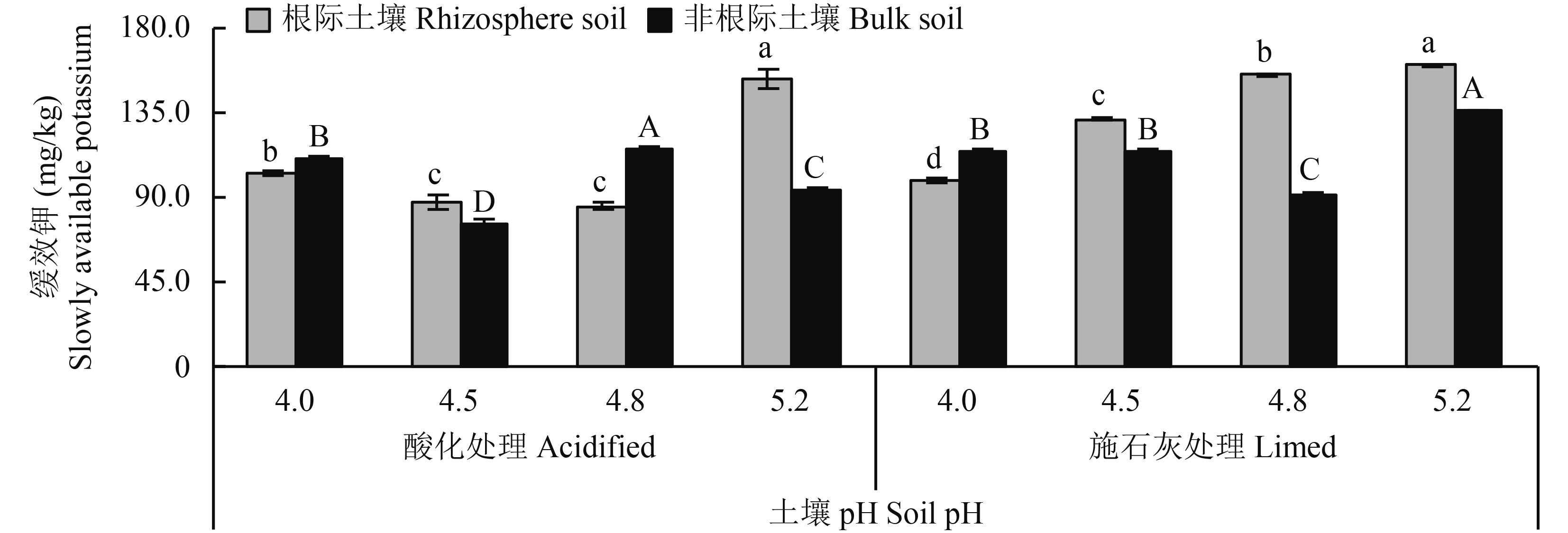 |
| 图3 酸化红壤及其经石灰改良至pH6.0后冬小麦收获时根际和非根际土壤缓效钾含量 Fig. 3 Slowly available potassium content in rhizospheric and bulk soil in acidified red soils before and after lime remediation to pH 6 at winter wheat harvest [注(Note):柱上不同小写字母表示酸化处理红壤各pH水平间差异显著Different lower case letters above the bars indicate the significant differences between pH level treatments in acidified soils at P < 5% level; 柱上不同大写字母表示石灰改良后红壤冬小麦生物量在不同初始pH水平处理间差异显著Different capital letters above the bars indicate significant difference among limed soils with differed with different initial pH values at P < 5% level] |
施石灰处理根际土壤缓效钾变幅为98.7~160.3 mg/kg,随初始pH升高显著升高(图 3);缓效钾和初始pH极显著正相关(y=53.75 pH-112.07,R2=0.9325**)。非根际土壤缓效钾变幅为91.7~136.0 mg/kg,表现为pH5.2 > pH4.5≥pH4.0 > pH4.8。在pH4.0下非根际土壤缓效钾显著高于根际土值,根际亏缺率达14.0%;在pH4.5、pH4.8和pH5.2下根际土壤缓效钾显著高于非根际土,根际富集率分别达14.5%、69.5%、17.9%。
2.5 酸化及石灰改良土壤钾离子饱和度变化酸化处理根际土壤钾离子饱和度变幅为1.5%~4.3%,随初始pH升高显著下降;非根际土壤钾离子饱和度介于4.3%~4.6%间,随pH升高呈升高趋势,pH5.2处理非根际土壤钾离子饱和度显著高于pH4.8处理,且两者均显著高于pH4.0和pH4.5处理(图 4)。pH4.5、4.8和5.2处理根际土壤钾离子饱和度亏缺率分别达48.8%、64.4%、67.4%。
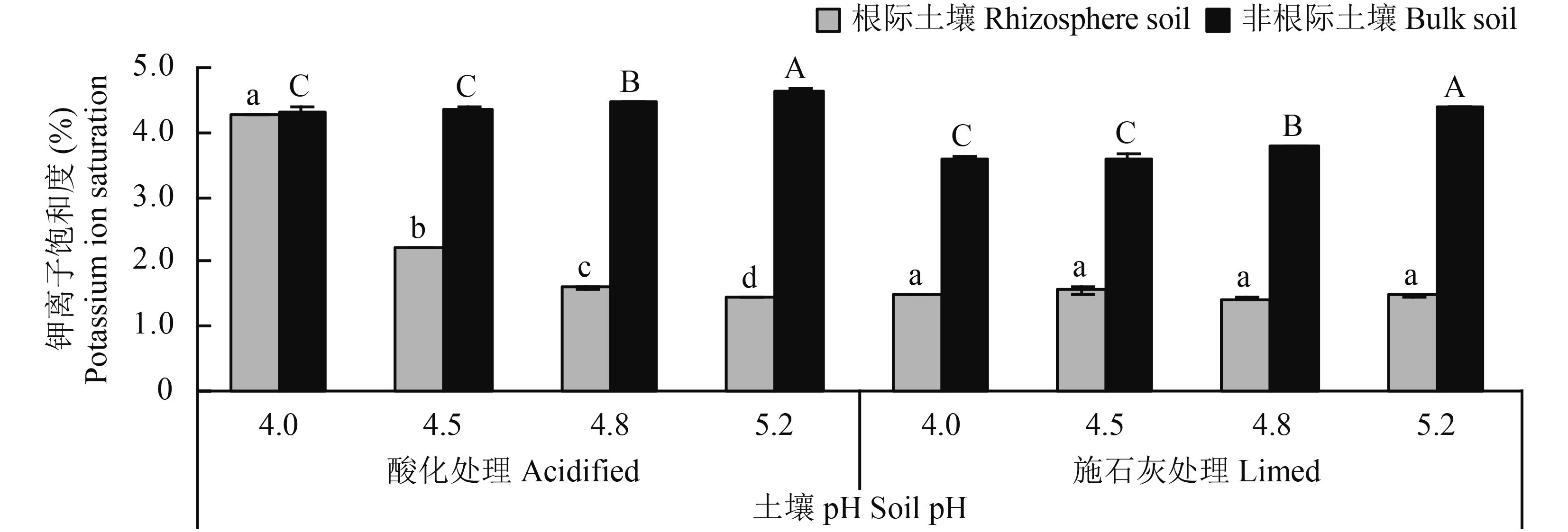 |
| 图4 酸化处理及其经石灰改良至pH6.0后冬小麦收获时根际和非根际土壤钾离子饱和度 Fig. 4 Potassium ion saturation in rhizospheric and bulk soil in acidified red soils before and after lime remediation to pH 6 at winter wheat harvest [注(Note):柱上不同小写字母表示酸化处理红壤各pH水平间差异显著Different lower case letters above the bars indicate the significant differences between pH level treatments in acidified soils at P < 5% level; 柱上不同大写字母表示石灰改良后红壤冬小麦生物量在不同初始pH水平处理间差异显著Different capital letters above the bars indicate significant difference among limed soils with differed with different initial pH values at P < 5% level] |
施石灰改良处理根际土壤钾离子饱和度变幅为1.5%~1.6%,但各处理间无显著差异。非根际土钾离子饱和度变化趋势与酸化处理下变化相一致(图 4),各处理均低于改良前相对应的酸化土壤,变幅为3.6%~4.4%。各处理根际土壤钾离子饱和度均显著低于对应的非根际土,pH4.0、4.5、4.8和5.2处理根际钾离子饱和度亏缺率分别达58.3%、55.6%、63.2%、65.9%。
2.6 土壤钾素、土壤pH和作物生长指标的关系表 2给出了根际土壤速效钾亏缺率与冬小麦吸钾量、根际土壤钾离子饱和度亏缺率、初始pH的关系,可以看出在酸化处理红壤上,冬小麦根际土壤速效钾亏缺率和冬小麦吸钾量与根际钾离子饱和度亏缺率呈极显著正相关;施石灰改良处理根际土壤速效钾亏缺率和初始pH呈显著负相关(表 2)。
| 表2 根际土壤速效钾亏缺率与冬小麦吸钾量、根际钾离子饱和度亏缺率、初始pH的线性相关 Table 2 Linear correlation of soil available K deficit rate as a function of K uptake, deficit rate and K+ saturation in rhizospheric soil and initial pH |
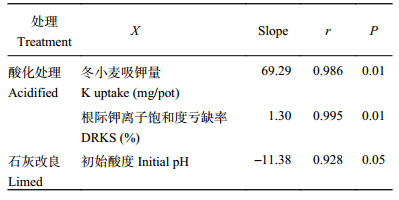 |
酸化处理下,冬小麦生物量与根际速效钾亏缺量呈极显著正相关(图 5),而施石灰改良后土壤冬小麦生物量与根际速效钾亏缺量呈显著负相关。
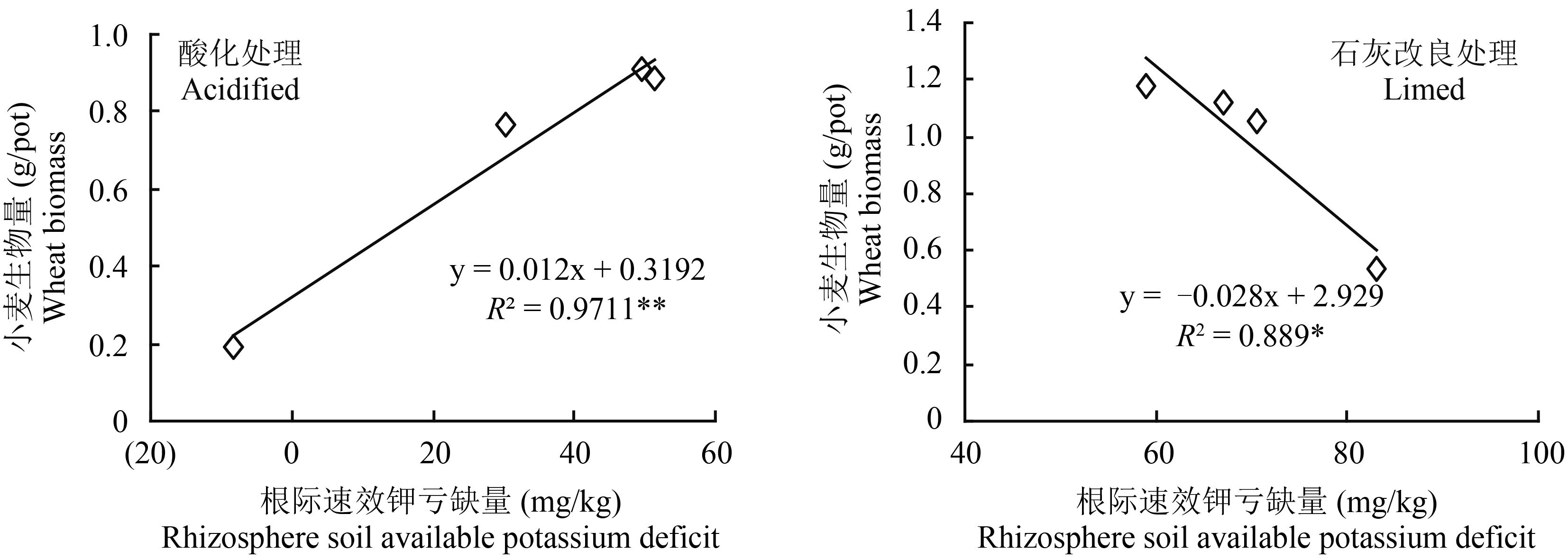 |
| 图5 冬小麦生物量与根际交换性钾亏缺量的关系(A)酸化土壤改良前(B)酸化土壤改良后 Fig. 5 The relationship between biomass of winter wheat and the deficit of soil available K (A) acidified soil (B) after lime remediation |
酸化土壤由于pH下降,土壤中正电荷增加,吸附在土壤胶体上的钙、镁、钾等阳离子被置换而随雨水淋失,同时土壤结构也发生改变而导致土壤肥力下降,影响作物生长。曾勇军等[39]研究发现随着土壤pH的下降,双季早、晚稻始穗期推迟,生育期延长,产量降低。张昌爱等[40]通过盆栽试验模拟酸化条件下油菜根系的生理生态变化情况,发现根的生物量、根系活力、根体积、根长度、根系的营养吸收量均受土壤酸化的影响。于天一等[41]研究发现旱地红壤酸化导致玉米产量连年下降。周海燕[42]研究发现小麦-玉米轮作体系下,酸化土壤限制了作物生长,导致作物产量极显著下降。土壤酸化使作物生长环境条件变差,过酸的土壤造成许多营养元素的有效性降低,使得土壤的宜种性降低,影响农业的可持续发展。本试验结果与上述研究结果类似。红壤酸化以后,冬小麦生长受到抑制,土壤酸度越低,抑制越严重(图 1)。一方面可能是随pH降低,过多的H+影响叶绿素含量及根系活力[43];另一方面,土壤酸化导致高活性铝的含量大幅度增加,铝毒害加剧了冬小麦生长受害的程度[44]。同样地,冬小麦生长的抑制导致了其对钾素的吸收的减少(图 1),这在其它研究中也有报道[35, 36]。酸化处理冬小麦生物量在pH 4.8与pH 5.2间无显著差异,而两者的吸钾量差异显著,可能和相对较高的pH条件下冬小麦根系受到胁迫相对较小有关。施用石灰矫正pH到6.0的处理均显著提高了冬小麦生物量和吸钾量,这是由于施石灰有效降低了土壤酸度,减轻了铝毒危害,促进了次生根发育,增强了冬小麦根系对水分和钾养分的吸收。冬小麦生物量和吸钾量随初始pH升高而升高可能和钾素等养分供应有关,因为矫正强酸化红壤需要加入的石灰量势必增大,过多的石灰施入可导致土壤钾素及磷等有效性降低[45–47]。
与过多施入石灰导致土壤钾素及磷等有效性降低不同,酸化处理根际土壤速效钾随pH降低而升高是由于低pH促进了土壤缓效钾释放;酸化及施石灰处理根际土壤速效钾显著低于非根际土壤,是由于作物吸收导致的根际土壤钾素消耗所致[48] (图 2)。但酸化处理pH 4.0时冬小麦根际土壤速效钾含量显著高于非根际(图 2),一方面可能由于在pH 4.0下土壤处于铝缓冲体系,铝大量溶出,Al3+是阳离子通道阻断剂,可阻断冬小麦根细胞的K+通道[49],因而降低了作物对钾素的吸收;另一方面,低pH促进了土壤缓效钾的释放。施石灰处理中,非根际土壤速效钾含量呈现出随初始pH升高而降低的趋势,可能是由于随pH升高,冬小麦生物量显著增加,蒸腾作用消耗水分较多,导致土壤钾素随水分(质流)向根际土壤迁移。和速效钾类似,酸化处理根际土壤缓效钾在pH 4.0-4.5间显著降低是因为作物钾吸收量显著增加,在pH 4.5、pH 4.8间无显著差异可能因为两者酸度相差较小所致。而在pH 5.2下根际土壤缓效钾显著高于其它3个处理,同样地可能是因为这个处理pH相对较高,根系所受胁迫较小,生长消耗水分较多使土壤钾素随水分(质流)由非根际土壤向根际土壤迁移,非根际土壤缓效钾较低也支持这一解释。施石灰改良处理下随初始pH值升高,根际土壤缓效钾出现富集,但非根际土缓效钾则随pH升高而降低,显然也是由于钾素随作物蒸腾作用增加随水移动导致的。
针对钾养分的富集或亏缺,相关分析发现,酸化条件下冬小麦根际土壤速效钾亏缺率和冬小麦吸钾量及根际钾离子饱和度亏缺率极显著正相关,是因为随pH升高,冬小麦受胁迫程度降低,其生长和吸钾强度增加,从而对根际土壤速效钾消耗增加,冬小麦生物量随之增加。施石灰处理根际土壤速效钾亏缺率与初始pH呈显著负相关及其与小麦生物量的关系,则可能是因为施石灰导致土壤速效钾固定增加[45–46],其机理需要做进一步研究。
4 结论1) 红壤酸化和石灰改良条件下土壤速效钾基本呈现出根际高于非根际,而钾离子饱和度则与之相反,但二者均受初始pH的显著影响。不同酸化土壤冬小麦根际土壤速效钾、钾离子饱和度均随土壤pH升高显著下降;施石灰改良后不同初始pH处理根际土壤速效钾、钾离子饱和度均显著低于对应的非根际土值。
2) 酸化严重限制了冬小麦植株生长及对钾的吸收,pH越低抑制作用越大,钾的生物有效性越低。不同pH下添加石灰均显著提高冬小麦生物量及吸钾量,在pH低于5.0时,添加石灰改良红壤提升冬小麦根际钾生物有效性的效应随初始pH升高逐渐降低。根际速效钾与钾离子饱和度可以较好地反应冬小麦的吸钾量,但酸化和石灰改良的反应效果不同。因此,研究红壤根际钾素能够较好地指导该地区钾素高效利用。
| [1] |
赵其国, 黄国勤, 马艳芹. 中国南方红壤生态系统面临的问题及对策[J].
生态学报, 2013, 33(24): 7615–7622.
Zhao Q G, Huang G Q, Ma Y Q. The problems in red soil ecosystem in southern of China and its counter measures[J]. Acta Ecologica Sinica, 2013, 33(24): 7615–7622. |
| [2] | Osei B A. Effects of different lime application rates and time on some chemical properties of an acid soil in Ghana[J]. Soil Use & Management, 1995, 11(1): 25–29. |
| [3] | Zhang H M, Wang B R, Xu M G. Effects of inorganic fertilizer inputs on grain yields and soil properties in a long-term wheat-corn cropping system in south China[J]. Communications in Soil Science & Plant Analysis, 2008, 39(11): 1583–1599. |
| [4] | Dobermann A, Cruz P S, Cassman K G. Fertilizer inputs, nutrient balance, and soil nutrient-supplying power in intensive, irrigated rice systems. I. Potassium uptake and K balance[J]. Nutrient Cycling in Agroecosystems, 1996, 46(1): 1–10. DOI:10.1007/BF00210219 |
| [5] |
黄国勤, 王兴祥, 钱海燕, 等. 施用化肥对农业生态环境的负面影响及对策[J].
生态环境, 2004, 13(4): 656–660.
Huang G Q, Wang X X, Q H Y, et al. Negative impact of inorganic fertilizers application on agriculture environment and its countermeasures[J]. Ecology and Environment, 2004, 13(4): 656–660. |
| [6] | Conyers M K, Tang C, Poile G J, et al. A combination of biological activity and the nitrate form of nitrogen can be used to ameliorate subsurface soil acidity under dryland wheat farming[J]. Plant & Soil, 2011, 348(2): 155–166. |
| [7] | Valentinuzzi F, Mimmo T, Cesco S, et al. The effect of lime on the rhizospheric processes and elemental uptake of white lupin[J]. Environmental & Experimental Botany, 2015, 118: 85–94. |
| [8] | Covaleda S, Pajares S, Gallardo J F, et al. Effect of different agricultural management systems on chemical fertility in cultivated tepetates of the Mexican transvolcanic belt[J]. Agriculture Ecosystems & Environment, 2009, 129(4): 422–427. |
| [9] |
徐仁扣, CoventryD R. 某些农业措施对土壤酸化的影响[J].
农业环境保护, 2002, 21(5): 385–388.
XU R K, Coventry D R. soil acidification as influenced by some agricultural practices[J]. Agro-environmental Protection, 2002, 21(5): 385–388. |
| [10] |
曾希柏. 红壤酸化及其防治[J].
土壤通报, 2000, 31(3): 111–113.
Zeng X B. Acidification of red soils and control methods[J]. Chinese Journal of Soil Science, 2000, 31(3): 111–113. |
| [11] |
陈梅, 沈其荣. 猪粪对红壤铝毒的缓解效应[J].
植物营养与肥料学报, 2002, 8(2): 173–176.
Chen M, Shen Q R. Amelioration of aluminum toxicity on wheat plants grown in acid red soil by pig manure[J]. Plant Nutrition and Fertilizer Science, 2002, 8(2): 173–176. |
| [12] | Cai Z J, Wang B R, Xu M G, et al. Intensified soil acidification from chemical N fertilization and prevention by manure in an 18-year field experiment in the red soil of southern China[J]. Journal of Soils and Sediments, 2014, 15(2): 260–270. |
| [13] |
朱青, 陈正刚, 尹迪信, 等. 中国西南地区坡地钾素平衡及管理措施探讨[J].
植物营养与肥料学报, 2006, 12(6): 772–777.
Zhu Q, Wang Z J, Chen Z G, et al. Potassium balance and management on sloping land in southwest China[J]. Plant Nutrition and Fertilizer Science, 2006, 12(6): 772–777. |
| [14] | Calba H, Zonkeng C, Ngonkeu E L M, et al. Responses of maize grain yield to changes in acid soil characteristics after soil amendments[J]. Plant & Soil, 2006, 284(1): 45–57. |
| [15] | Guo J H, Liu X J, Zhang Y, et al. Significant acidification in major Chinese croplands[J]. Science, 2010, 327(5968): 1008–1010. DOI:10.1126/science.1182570 |
| [16] |
和林涛.长期施肥土壤-作物体系钾素动态变化研究[D].重庆:西南大学硕士论文, 2008.
He L T. Study on dynamic change of potassium in soil-plant system under long-term fertilization[D]. Chongqing:Master Dissertation of Southwest University, 2008. |
| [17] |
张福锁, 曹一平. 根际动态过程与植物营养[J].
土壤学报, 1992, 29(3): 239–250.
Zhang F S, Cao Y P. Rhizospheric dynamics and plant nutrition[J]. Acta Pedologica Sinica, 1992, 29(3): 239–250. |
| [18] | Barber S A. Soil Nutrient Bioavailability:a Mechanistic Approach[J]. Journal of Applied Bacteriology, 1974, 37: 583–593. DOI:10.1111/jam.1974.37.issue-4 |
| [19] |
邹春琴, 李振声, 李继云. 小麦对钾高效吸收的根系形态学和生理学特征[J].
植物营养与肥料学报, 2001, 7(1): 36–43.
Zou C Q, Li Z S, Li J Y. Study on difference in morphological and physiological characters of wheat varieties to potassium[J]. Plant Nutrition and Fertilizer Science, 2001, 7(1): 36–43. |
| [20] |
李小坤.水旱轮作条件下根区与非根区土壤钾素变化及固定释放特性研究[D].武汉:华中农业大学博士论文, 2009.
Li X K. Study on the dynamics of soil potassium in root zone and non-root zone and the characteristic of potassium fixation-release under paddy-upland rotation[D]. Chongqing:PhD Dissertations of Huangzhong Agricultural University, 2009. http://cdmd.cnki.com.cn/Article/CDMD-10504-2010011369.htm |
| [21] |
施卫明. 根系分泌物与养分有效性[J].
土壤, 1993, 25(5): 252–256.
Shi W M. Root exudates and nutrition availability[J]. Soils, 1993, 25(5): 252–256. |
| [22] |
丛日环, 李小坤, 鲁剑巍, 等. 不同水分状况对红壤和黄褐土速效钾含量的影响[J].
植物营养与肥料学报, 2009, 15(5): 1072–1077.
Cong R H, Li X K, Lu J W, et al. Effects of water conditions on available potassium contents in red soil and yellow-cinnamon soil[J]. Plant Nutrition and Fertilizer Science, 2009, 15(5): 1072–1077. |
| [23] |
周六凤.不同种植方式下红壤和黄褐土的供钾能力与施钾效果研究[D].武汉:华中农业大学硕士论文, 2009.
Zhou L F. Study on soil K-supplying potential and potassium application effect on red soil and yellow cinnamon soil under different planting patterns[D]. Wuhan:Master Dissertations of Huazhong Agricultural University, 2009. |
| [24] |
李小梅.钾素水平对油茶林养分积累、果实产量和含油量的影响[D].江西农业大学硕士论文, 2014.
Li X M. Effects of potassium levels on nutrient accumulation, fruit yield and oil content of Camellia oleifera[D]. Master Dissertations of Jiangxi Agricultural University, 2014. http://cdmd.cnki.com.cn/Article/CDMD-10410-1014402436.htm |
| [25] |
胡国松, 曹志洪, 周秀如, 等. 烤烟根际土壤中钾素及微素行为的研究[J].
中国烟草学报, 1993(1): 1–11.
Hu G S, Cao Z H, Zhou X R, et al. Studies on the behaviour of potassium and trace elements in rhizospheric soil of flue-cured tobacco[J]. Acta Tabacaria Sinica, 1993(1): 1–11. |
| [26] |
王益福, 洪祯瑞. 皖南红壤丘陵茶园土壤养分与根际微生物活动的关系[J].
茶叶科学, 1986, 6(1): 29–34.
Wang Y F, Hong Z R. Relationship between the soil nutrients and rhizospheric microbial activity in the soil of tea gardens in laterite hilly region of south Anhui[J]. Journal of Tea Science, 1986, 6(1): 29–34. |
| [27] |
张桃林, 李忠佩, 王兴祥. 高度集约农业利用导致的土壤退化及其生态环境效应[J].
土壤学报, 2006, 43(5): 843–850.
Zhang T L, Li Z P, Wang X X. Soil degradation and its eco-environmental impact under highly-intensified agriculture[J]. Acta Pedologica Sinica, 2006, 43(5): 843–850. |
| [28] |
易杰祥, 吕亮雪, 刘国道. 土壤酸化和酸性土壤改良研究[J].
华南热带农业大学学报, 2006, 12(1): 23–28.
Yi J X, Lv L X, Liu G D. Research on soil acidification and acidic soil's melioration[J]. Journal of South China University of Tropical Agriculture, 2006, 12(1): 23–28. |
| [29] |
陈祖筹. 酸性红壤施石灰对甘蔗养分状况某些酶活性及生长的影响[J].
热带亚热带土壤科学, 1994, 3(1): 21–26.
Chen Z C. Effects of lime application to acid red soil on nutrient status, enzyme activities[J]. Tropical and Subtropical Soil Science, 1994, 3(1): 21–26. |
| [30] |
唐莉娜, 熊德中. 酸性土壤施石灰对土壤性质与烤烟品质的影响[J].
中国生态农业学报, 2003, 11(3): 81–83.
Tang L N, Xiong D Z. Effects of applying lime on the properties of acid soil and the leaves quality in flue-cured tobacco[J]. Chinese Journal of Eco-Agriculture, 2003, 11(3): 81–83. |
| [31] |
何锦林, 谭红. 酸性黄壤施石灰对白三叶草养分影响的研究[J].
中国草地, 1995(3): 34–37.
He J L, Tan H. Effect of liming on white clover nutrient value in acid yellow earth[J]. Grassland of China, 1995(3): 34–37. |
| [32] |
蔡东, 肖文芳, 李国怀. 施用石灰改良酸性土壤的研究进展[J].
中国农学通报, 2010, 26(9): 206–213.
Cai D, Xiao W F, Li G H. Advance on study of liming on acid soils[J]. Chinese Agricultural Science Bulletin, 2010, 26(9): 206–213. |
| [33] |
张效朴, 郑根宝. 连续施石灰对作物生长及其养分吸收的影响[J].
土壤学报, 1987, 24(4): 243–251.
Zhang X P, Zheng G B. Effect of continuous liming on crop growth and their absorption of nutrients[J]. Acta Pedologica Sinica, 1987, 24(4): 243–251. |
| [34] |
孙波, MoreauR, PossR, 等. 第四纪红粘土发育的红壤在施用石灰和石膏后元素的淋溶特征[J].
土壤学报, 2000, 37(1): 50–61.
Sun B, Moreau R, Poss R, et al. Characteristics of element leaching of red soil derived from quaternary red clay supplied with lime and gypsum[J]. Acta Pedologica Sinica, 2000, 37(1): 50–61. |
| [35] |
蔡泽江.长期施肥下红壤酸化特征及影响因素[D].北京:中国农业科学院硕士论文, 2010.
Cai Z J. Acidification characteristics of red soil under long-term fertilization and effect factors[D]. Beijing:Master Dissertation of Chinese Academy of Agricultural Sciences, 2010. http://www.oalib.com/references/16871571 |
| [36] |
姜军, 徐仁扣, 赵安珍. 用酸碱滴定法测定酸性红壤的pH缓冲容量[J].
土壤通报, 2006, 37(6): 1247–1248.
Jiang J, Xu R K, Zhao A Z. Determination of pH Buffer Capacity of Acid Red Soils by Acid-Base Titration[J]. Chinese Journal of Soil Science, 2006, 37(6): 1247–1248. |
| [37] |
鲁如坤, 史陶均.
农业化学手册
[M]. 北京: 科学出版社, 1982.
Lu R K, Shi T J. Agricultural chemical manual [M]. Beijing: Science Press, 1982. |
| [38] |
马斌, 周志宇, 张彩萍, 等. 超旱生灌木根际土壤磷的含量特征[J].
草业学报, 2005, 14(3): 106–110.
Ma B, Zhou Z Y, Zhang C P, et al. The character of phosphorus concentration in rhizospheric soil of super xerrphytic shrubs[J]. Acta Prataculturae Sinica, 2005, 14(3): 106–110. |
| [39] |
曾勇军, 周庆红, 吕伟生, 等. 土壤酸化对双季早、晚稻产量的影响[J].
作物学报, 2014, 40(5): 899–907.
Zeng Y J, Zhou Q H, Lǚ W S, et al. Effect of soil acidification on the yield of double season rice[J]. Acta Agronomica Sinica, 2014, 40(5): 899–907. DOI:10.3724/SP.J.1006.2014.00899 |
| [40] |
张昌爱, 劳秀荣. 模拟酸化条件下油菜根系的生理生态变化[J].
中国农学通报, 2003, 19(3): 79–81.
Zhang C A, Lao X R. Effect on rape roots of soil's mimicry acidifying in green shed[J]. Chinese Agricultural Science Bulletin, 2003, 19(3): 79–81. |
| [41] |
于天一, 李玉义, 逄焕成, 等. 长期不施磷肥对旱地红壤养分比例与玉米产量的影响[J].
中国土壤与肥料, 2010(2): 25–28.
Yu T Y, Li Y Y, Feng H C, et al. Effect of long-term phosphorus fertilization to up land red soil nutrients ratio and maize yield[J]. Soil and Fertilizer Sciences in China, 2010(2): 25–28. |
| [42] |
周海燕.胶东集约化农田土壤酸化效应及改良调控途径[D].北京:中国农业大学博士论文, 2015.
Zhou H Y. Effect of cropland soil acidification and remediation in Jiaodong of Shandong Province[D]. Beijing:PhD Dissertations of China Agricultural University, 2015. http://cdmd.cnki.com.cn/Article/CDMD-10019-1015582971.htm |
| [43] |
童贯和, 程滨, 胡云虎. 模拟酸雨及其酸化土壤对冬小麦幼苗生物量和某些生理活动的影响[J].
作物学报, 2005, 31(9): 1207–1214.
Tong G H, Cheng B, Hu Y H. Effect of simulated acid rain and its acidified soil on the biomass and some physiological activities of wheat seedlings[J]. Acta Agronmica Sinica, 2005, 31(9): 1207–1214. |
| [44] |
黄巧云, 李学垣, 徐凤琳. 土壤酸化过程中铝的形态与冬小麦缺钙和铝毒发生的条件[J].
华中农业大学学报, 1995, 14(2): 147–153.
Huang Q Y, Li X Y, Xu F L. Relationship of active aluminum forms during soil acidification with calcium deficiency and aluminum toxicity for wheat[J]. Journal of Huazhong Agricultural Universiy, 1995, 14(2): 147–153. |
| [45] | Curtin D, Smillie G W. Effects of liming on soil chemical characteristics and grass growth in laboratory and long-term field-amended soils[J]. Plant and Soil, 1986, 95(1): 15–22. DOI:10.1007/BF02378848 |
| [46] | Jaskulska I, Jasklski D, kobierski M. Effect of liming on the change of some agrochemical soil properties in a long-term fertilization experiment[J]. Plant Soil and Environment, 2014, 60(4): 146–150. |
| [47] | Valentinuzzi F, Mimmo T, Cescos, et al. The effect of lime on the rhizospheric processes and elemental uptake of white lupin[J]. Environmental and Experimental Botany, 2015, 118: 85–94. DOI:10.1016/j.envexpbot.2015.06.010 |
| [48] |
李小坤, 鲁剑巍, 吴礼树, 等. 油菜-水稻轮作下根区与非根区红壤性水稻土钾素变化研究[J].
土壤学报, 2010, 47(3): 508–514.
Li X K, Lu J W, Wu L S, et al. Dynamics of potassium in root-zone and non-root-zone red paddy soil under rapeseed-rice rotation[J]. Acta Pedologica Sinica, 2010, 47(3): 508–514. |
| [49] |
肖厚军, 王正银. 酸性土壤铝毒与植物营养研究进展[J].
西南农业学报, 2006, 19(6): 1180–1188.
Xiao H J, Wang Z Y. Advance on study of aluminum toxicity and plant nutrition in acid soils[J]. Southwest China Journal of Agricultural Sciences, 2006, 19(6): 1180–1188. |
 2016, Vol. 22
2016, Vol. 22  doi:
doi: 

